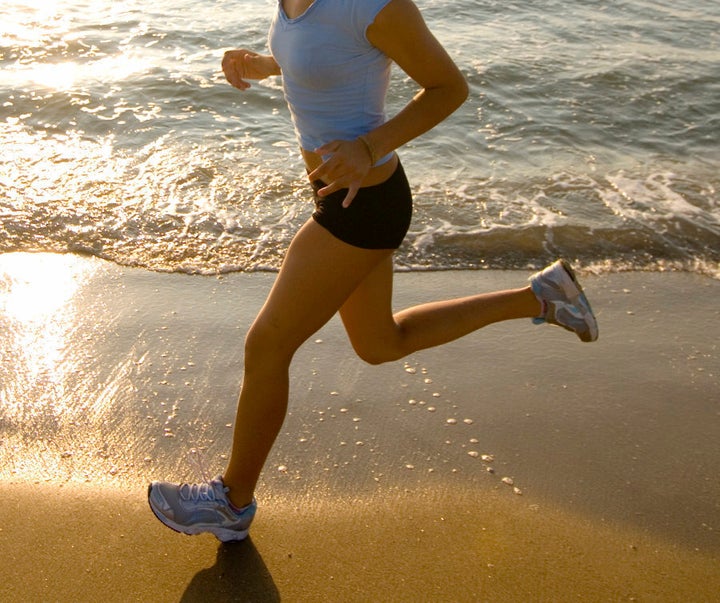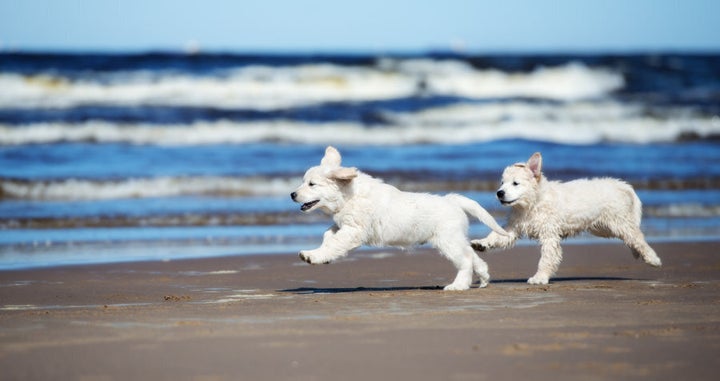
If you're going to run, why not ditch the treadmill and do it by the beach, instead? Sure, not everyone lives coastal, but if you do there are many benefits to soft sand running.
It might surprise some people how different it is to ordinary running, too.
"The difference between soft sand running and regular running is in the stability needed when running in soft sand compared to a harder surface like on a road or track," Kevin Toonen, strength and conditioning coach for the Australian military and expert for Body Science told The Huffington Post Australia.
"Your ligaments, tendons and muscles -- both large and small -- will have to work a lot harder and get fatigued quicker when running on soft sand. Due to the uneven surface provided by the sand the body will have to compensate to stay in a technically proficient running pose. So when running on soft sand compared to a normal road run you will probably notice your weak areas a lot sooner than you normally would. This could come in the form of muscle pain, muscle fatigue or even some joint pain. You will work harder running on the soft sand."

Personal trainer Dylan Rivier agrees.
"Soft sand running is one of the most grueling and unforgiving types of exercise you can do. It's also one of the most rewarding. For starters, you're on a soft surface, obviously, and the very nature of this means that there is a lot less energy (or spring) in your step as each foot sinks into the sand, so rather than driving forward off a hard surface, it becomes more about lifting the leg each time. This means that you have to work a lot harder than you would on a hard surface," Rivier told Huff Post Australia.
As for where on the beach you should be training -- up the back on the soft stuff or down closer to the shore where it's firmer -- that comes down to your fitness level.
"Where on the beach you should run all depends on your current conditioning level, your injury status and what your looking at getting out of the session. If you are just starting out running on the sand then I would suggest running on the harder surface first. This way you will get used to the different way your body has to work when running on a uneven, soft surface," Toonen said.
"If you have spent some time building on your running on the sand then spend some time on the hard and then soft sand, the time spent will depend on when you start to fatigue and your form suffers, you have to be smart when doing this, injuries can happen when you don't ease into new things."

Rivier suggests a mix of sprints and longer runs if you want to get the most out of your soft sand workout.
"I do a mixture of both long slow steady pace or short sharp sprints with my bootcamps and the results are fantastic."
For Toonen it's about approaching the session with a purpose.
"I always plan my sessions for a particular reason with a calculated outcome in mind. So I would assume most runners are using this as a add on or as a intensity session, otherwise you're just strolling on the beach and that's not what our bodies are designed for!"
Toonen suggests the following workout:
- Start with a dynamic warm up, focusing on glutes, hamstrings, calfs, lower back and hips and shoulders.
- Then do a 60-70 meter sprint at about 85-90 percent of your max effort. It should take you 12-15 seconds.
- Rest for 15 seconds and repeat 15-20 times.
- Rest 4-6 minutes before repeating the above.
Before you embark on and soft sand sessions, Toonen has some words of advice.
"If you have any lower leg injuries then you will have to be wary of how much you do and when you run these sessions. The sand will fatigue your body a lot faster then normal running and once it is tired you are in danger of loosing form."
"Secondly, don't forget to warm up. I see so many people do a quick calf or hamstring stretch and then head off for a run, and then wonder why they pull up sore, injured or have lower back pain within minutes of the session. Posterior activation is paramount! Your glutes, hamstrings and calves must be switched on and ready to work before you start your session. You'll be so surprised at how a 10 to 15 minute warm up done correctly and specifically for running will improve your running session and subsequent performance week in and week out. Don't be lazy, do the work," Toonen said.
Click below to follow HuffPost Australia on Snapchat!
